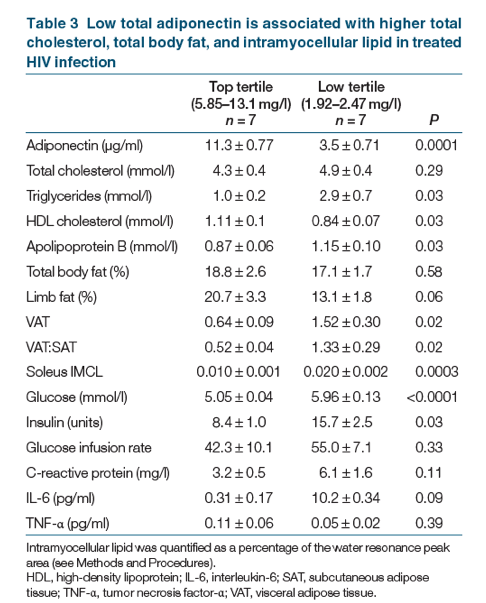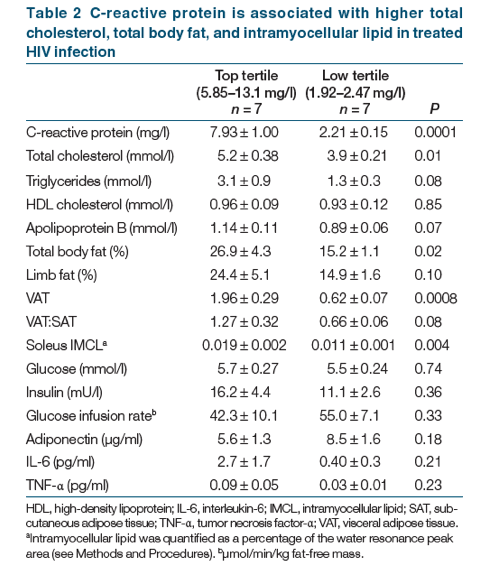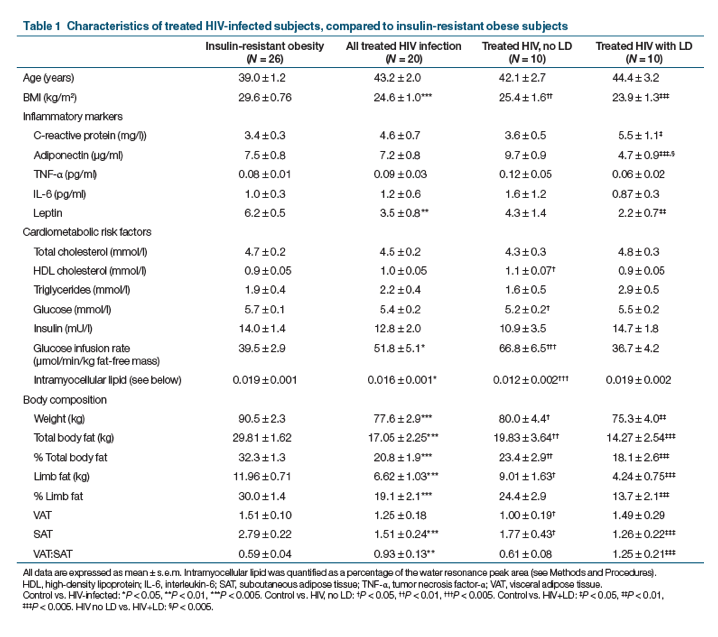| |
Lipodystrophy Not Forgotten - Proinflammatory Markers, Insulin Sensitivity, and
Cardiometabolic Risk Factors in Treated HIV Infection - in causing heart disease
|
| |
| |
Download the PDF here
"Adiponectin remained lower in treated HIV infection compared to IR-O [insulin resistant obese] after adjustment for %TBF, total body fat, (P = 0.0001) and VAT:SAT(P = 0.007)......Low adiponectin is associated with visceral obesity and predicts CVD (25) and T2DM (26). Other proinflammatory adipocyte products such as interleukin-6 (IL-6) and tumor necrosis factor-α (TNF-α) are also implicated.......In conclusion, a proinflammatory milieu equivalent to that of insulin-resistant obesity characterizes lean men with treated HIV infection, worse in those with subcutaneous lipoatrophy. These factors may contribute to the accelerated diabetogenesis and cardiac risk observed in treated HIV infection."
Obesity 2009
Katherine Samaras1,2, Seng K. Gan1,3, Phillip W. Peake4, Andrew Carr1 and Lesley V. Campbell1,2
Adiponectin remained lower in treated HIV infection compared to IR-O [insulin resistant obese] after adjustment for %TBF, total body fat, (P = 0.0001) and VAT:SAT (P = 0.007).
There is increasing recognition that adipose tissue and disturbed adipocyte physiology contribute to the inflammatory milieu. C-reactive protein (CRP) levels are strongly associated with adipose tissue mass (19) and predict CVD (20,21) and T2DM (22,23,24). Low adiponectin is associated with visceral obesity and predicts CVD (25) and T2DM (26). Other proinflammatory adipocyte products such as interleukin-6 (IL-6) and tumor necrosis factor-α (TNF-α) are also implicated.
In the most significant and possibly irreversible HAART metabolic complication, lipoatrophy, disturbed adipocyte function may exacerbate preexisting insulin resistance (6), hyperlipidemia and contributes to metabolic syndrome (27,28,29). In this patient group, we have previously shown that LD (lipoatrophy with abdominal lipohypertrophy) is associated with disturbed glucose metabolism, reduced insulin action, intramyocellular triglyceride accumulation (6), and low adiponectin (27). Disturbed secretion of other adipocyte-derived proinflammatory molecules in treated HIV infection may also contribute to systemic inflammation and its consequences.
This study examined markers of systemic inflammation in HIV-infected men receiving HAART with and without LD (lipoatrophy with abdominal lipohypertrophy), compared to fat-free mass-matched men with insulin-resistant obesity, a risk group predisposed to CVD and T2DM, with reference to cardiovascular risk factors and markers of disturbed insulin action (insulin sensitivity and intramyocellular lipids (IMCLs)).
The presence of LD in HIV-infected HAART recipients (HIV+LD) was associated with significantly higher CRP and lower adiponectin and leptin compared to insulin-resistant obesity (Table 1, Figure 1). In HIV+LD, adiponectin was also significantly lower than that found in treated HIV without LD (Table 1, Figure 1). There were no relationships between CRP, adiponectin, TNF-α and IL-6 with CD4 count or viral load (data not shown).
Abstract
Treated HIV infection and HIV-lipoatrophy increases risk of cardiovascular disease (CVD) and type 2 diabetes mellitus (T2DM). Circulating inflammatory molecules may, in part, explain this increased risk. This study examined circulating inflammatory molecules in treated HIV infection in relation to insulin sensitivity, lipids total body, and intramyocellular fat, compared to insulin-resistant obesity (an index group at high risk of diabetes). Detailed metabolic phenotypes were measured in 20 treated HIV-infected men (with and without subcutaneous lipoatrophy) vs. 26 insulin-resistant obese men (IR-O, n = 26), including inflammatory molecules, insulin sensitivity, total body fat (TBF), visceral fat (visceral adipose tissue (VAT)), and intramyocellular lipid (IMCL). C-reactive protein (CRP) levels in treated HIV were similar to those in IR-O, despite lower TBF and greater insulin sensitivity in treated HIV. In HIV-lipoatrophy, CRP was higher than that found in IR-O. Adiponectin was similar between treated HIV and IR-O, but significantly lower in those with HIV-lipoatrophy. In treated HIV, subjects with higher CRP had significantly higher total cholesterol, VAT, and IMCL. In treated HIV, subjects with lower adiponectin had significantly lower HDL and higher triglycerides, glucose, VAT, and IMCL. In conclusion, a proinflammatory milieu equivalent to that of insulin-resistant obesity characterizes lean men with treated HIV infection, worse in those with subcutaneous lipoatrophy. These factors may contribute to the accelerated diabetogenesis and cardiac risk observed in treated HIV infection.
Body fat partitioning and impact on CRP and adiponectin
Despite matching for fat-free mass, HIV-infected HAART recipients as a group had lower TBF, fat, and SAT but similar VAT and higher VAT:SAT, compared to insulin-resistant obese (Table 1). Similarly, HIV+LD had lower total body and limb fat, lower SAT, similar VAT and a higher VAT:SAT, compared to insulin-resistant obesity, although the differences were more marked (Table 1). In subgroup analyses, HIV-infected subjects without LD had significantly lower VAT compared to controls, though VAT:SAT was similar (Table 1).
Because treated HIV infection had both significantly lower %TBF and higher VAT:SAT than IR-O, analyses were undertaken of CRP and adiponectin adjusted for %TBF and VAT:SAT, to determine whether the differences observed in inflammatory markers were independent of differences in TBF. CRP remained higher in treated HIV infection vs. IR-O after adjustment for %TBF (P = 0.001) and VAT:SAT (P = 0.04). Adiponectin remained lower in treated HIV infection compared to IR-O after adjustment for %TBF (P = 0.0001) and VAT:SAT (P = 0.007).



|
|
| |
| |
|
|
|